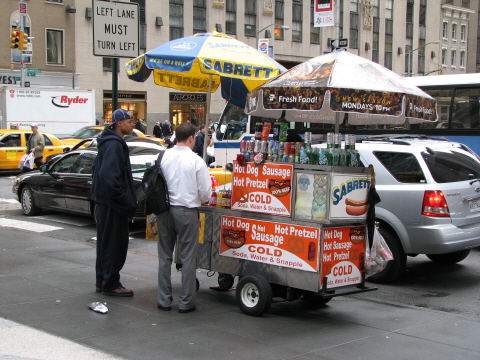
The Moveable Curbside Feast
Food trucks and carts have become an increasingly common part of the urban landscape. The New York City Council is considering a plan to overhaul their regulation that would double the number of permits. But some say that would harm existing businesses and clog streets. Should New York and other cities permit more food vendors?
* curbside(= kerbside) = 차도 가장자리/ feast = 연회, 잔치; 향연/ increasingly = 점점 더, 갈수록 더/ urban landscape = 도시적 경관/ overhaul = 점검[정비]하다/ double = 두 배[갑절]로 만들다/ permit = 허가증/ harm = 해를 끼치다, 손상시키다/ clog = 막다; 막히다/ food vendor = 음식 노점상
 뉴욕 그리고 다른 도시들은 더 많은 음식 노점상을 허락해야 하나요?
뉴욕 그리고 다른 도시들은 더 많은 음식 노점상을 허락해야 하나요?
1. More Food Carts, and Better Enforcement
New York, and other cities, need to better enforce pollution rules and allocate street and sidewalk space more efficiently.
2. A Public Space Issue that Affects Businesses and Overcrowded Streets
New York's guidelines for food vendors must account for the increase in road and sidewalk congestion.
3. I’ve Waited 20 Years for a Food Vending Permit
Granting more permits will help thousands of us vendors improve our lives and feed working people who depend on us for affordable meals.
Sample Essay
A Public Space Issue that Affects Businesses and Overcrowded Streets
Street vendors are an integral part of the fabric of New York. But the city is pushing ahead with underdeveloped legislation for their expansion. This well-intentioned, but misguided, strategy fails to accurately account for the incredible increase in road and sidewalk congestion, at a time when the city's population is at a record high of 8.5 million residents.
The governance of street vending must be tailored to the specific needs of each city. Nearly every aspect of a city’s public space, including the sidewalks, is regulated and has specific guidelines for how entities operate within them. Criteria for siting and for local input — from business improvement district groups, community boards, etc. — isn't just important for food trucks, but for any amenity or private enterprise that affects the streetscape. In New York, bike racks and newsstands are subject to this kind of approval, so carts that vend on public spaces should be subject to similar guidelines.
Yet, there has been no study of the existing vending climate in New York that would inform new legislation to modernize the system. Instead, 4,200 new vendor licenses are set to be issued over the next seven years — a 100 percent increase from the current cap — and there is no criteria for regulating placement of the new vendors, no basic siting guidelines and no plan for citing vendors who illegally occupy public space.
The effort to reform the city’s antiquated street vending system is no doubt a necessary one, but greater consideration should be given to businesses and the lives of New Yorkers affected by this legislation and the unintended consequences that will arise. Without a better understanding of the current makeup of vendors, where they operate, and how many do so illegally, justifiable reform is logically impossible.
The use of public space is a fundamental issue for cities. New York's legislation is not accounting for it, in that it leaves open the ability for vendors to encroach even more onto public space, already in limited supply in an overcrowded metropolis. Increasing the amount of space that a vendor can be from the curb, the crosswalk, or subway entrance is an assault on pedestrian safety, right-of-way access and public space. Further reducing sidewalk space to benefit a vendor is the privatization of public space and counterproductive to pedestrian safety.
What is clearly a well-intentioned impulse to reform a flawed system for food vendors would benefit from more study and a more comprehensive approach.





![]() 뉴욕 그리고 다른 도시들은 더 많은 음식 노점상을 허락해야 하나요?
뉴욕 그리고 다른 도시들은 더 많은 음식 노점상을 허락해야 하나요?






